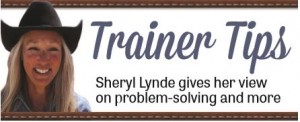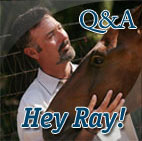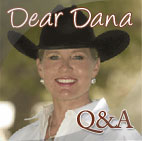Think outside the box
"It’s important to keep in mind that aggression does not resolve aggression."
 A 3-year-old gelding was brought to me to get started — a stud colt until a couple months prior to his arrival. He’d been shown in halter and had prodigious breeding, but he had begun to display deliberately aggressive behavior like biting, striking and kicking.
A 3-year-old gelding was brought to me to get started — a stud colt until a couple months prior to his arrival. He’d been shown in halter and had prodigious breeding, but he had begun to display deliberately aggressive behavior like biting, striking and kicking.
Temperament of stallions varies because of factors such as genetics and training, but because of their instincts as herd animals they require knowledgeable management by experienced handlers. Even though this colt had been gelded prior to coming to me, he was still exhibiting “stallion behavior.” It takes about 60 days for hormonal levels of testosterone to become insignificant for breeding; however, the behavior is brain-related, not merely hormonal, and it can become habitual. Stallion-like behavior can linger well after the hormonal effects of testosterone have diminished, that was the case with this gelding.
Did your horse ‘fire’ you?
“Bucking is used to establish a pecking order. The unwelcomed behaviors are the horses’ natural instinct to test your role as leader in the partnership …”
 Are you noticing changes in your horse’s attitude when he is being handled or under saddle that is causing you to be concerned? Is he more attentive to pasture mates and other horses when out on the trail than he is on you? Do you feel “out-of-your-depth” when you try to safely identify and resolve the unwanted behaviors? Well, he could be challenging your position in the pecking order. It’s possible you have been fired!
Are you noticing changes in your horse’s attitude when he is being handled or under saddle that is causing you to be concerned? Is he more attentive to pasture mates and other horses when out on the trail than he is on you? Do you feel “out-of-your-depth” when you try to safely identify and resolve the unwanted behaviors? Well, he could be challenging your position in the pecking order. It’s possible you have been fired!
Smokey: A study of heart
 Smokey is a 3-year-old Quarter Horse gelding. The owner needed my help with some fear-related issues that Smokey had. Although he had been started, the owner had some concerns and didn’t feel comfortable riding him.
Smokey is a 3-year-old Quarter Horse gelding. The owner needed my help with some fear-related issues that Smokey had. Although he had been started, the owner had some concerns and didn’t feel comfortable riding him.
He had quality breeding that showed in his natural athleticism, but his moves were bigger than necessary and unpredictable. When he first arrived, I put him in the round pen just to let him get acclimated to his new surroundings. I stood in the distance and watched as he spooked at something, lost his footing and actually fell over — all by himself! The owner’s concerns were well-founded, and I had to get Smokey’s behavior corrected not only for the owner’s safety, but for Smokey’s well-being, too. Horses don’t want to live in fear any more than we do. They are looking for someone whom they can draw confidence from, someone to show them a better way to handle their emotions. If he didn’t get help with his fear at this juncture, then his reactions would have continued to escalate. He couldn’t resolve this on his own.
Removing trailer-loading anxiety
 A client once brought a horse to me that had developed trailer-loading issues. It had endured an accident while being tied inside a trailer, and she had pulled back, resulting in minor injuries both physically and mentally. Subsequently, the owner had difficulty getting her into the trailer, and even once in, she would want out — and fast. She could fly backward.
A client once brought a horse to me that had developed trailer-loading issues. It had endured an accident while being tied inside a trailer, and she had pulled back, resulting in minor injuries both physically and mentally. Subsequently, the owner had difficulty getting her into the trailer, and even once in, she would want out — and fast. She could fly backward.
If you break it down, there are a couple of issues here. In addition to her anxiety while in the trailer, she also had an issue with pulling back. I’ll tackle Issue No. 1 first, which is her overall anxiety while inside the trailer. If I were able to eliminate her anxiety and help her to feel more at ease in the trailer, she would be less likely to pull back.
To start, I removed a panel from my round pen and then backed my trailer up to the opening until it was flush with the other panels. While standing inside the round pen facing the trailer door, I opened the door of the trailer to my right until it swung flush to a panel, where I secured it. To the left of the trailer opening, I pulled that round-pen panel, so it was even with the trailer and secured it there, leaving no spaces or unsafe edges between the panels and the opening of the trailer. I left the truck hitched to the trailer to make sure it remained stable while the horse loads and unloads.
To judge, or NOT to judge
 We are confronted with a multitude of distractions every day. It takes an ongoing awareness and effort to leave the world outside the arena in order to learn to focus on ourselves and our horse. Quieting your mind and letting go of distractions allows you to concentrate on your body and your horse’s movements. Attainment of any goal you set, whether it is mastering a specific maneuver or overcoming a habit you have judged as a bad one, depends on your mental game.
We are confronted with a multitude of distractions every day. It takes an ongoing awareness and effort to leave the world outside the arena in order to learn to focus on ourselves and our horse. Quieting your mind and letting go of distractions allows you to concentrate on your body and your horse’s movements. Attainment of any goal you set, whether it is mastering a specific maneuver or overcoming a habit you have judged as a bad one, depends on your mental game.
This takes an understanding of the “inner game” of your mind. It’s the first step that moves aside confusion and fear, replacing them with confidence regardless of the circumstances or surroundings. Being focused on each maneuver is just as instrumental to your training regime as the reins are to the bridle.
In the book “The Inner Game of Tennis,” author W. Timothy Gallway defines judging our efforts as a culprit that leads to trying too hard. For instance, when riders continually judge or place a negative value to a habit as “bad,” such as always leaning in turns, they will begin to identify themselves with the habit itself. They bring this identification to their riding lesson and their focus changes from being aware of what their body is doing to the mindset of what NOT to do.
Clinic case: break progress into steps
 During the three-day Norco Horse Affair last month, I gave a demonstration on Dude, a 9-year old Mustang that lacked confidence. His current owner has owned him for two years, and prior to that he had been owned by four others.
During the three-day Norco Horse Affair last month, I gave a demonstration on Dude, a 9-year old Mustang that lacked confidence. His current owner has owned him for two years, and prior to that he had been owned by four others.
Because of an injury to the current owner (unrelated to Dude), the horse had not been ridden, saddled, or even removed from the property for a year. Just entering his pen, he was apprehensive and reactive. Prior to her injury, the owner had been riding Dude with no issues under saddle other than the occasional crow-hopping. The biggest issue was saddling – she had never really been able to saddle him while quietly standing tied. She would lunge him, and if she managed to land the saddle on his back without him making a dash, that would be a successful session.
Making of a ‘Keeper’ takes time
 In preparation for my upcoming demonstrations at the Norco Horse Affair Oct. 6-8, I sent out a request for a fearful horse to use. Immediately, I received responses and videos. I selected the first one I received, but another horse that came in later reminded me of an 18-month-old colt that once was sent to me to start.
In preparation for my upcoming demonstrations at the Norco Horse Affair Oct. 6-8, I sent out a request for a fearful horse to use. Immediately, I received responses and videos. I selected the first one I received, but another horse that came in later reminded me of an 18-month-old colt that once was sent to me to start.
Starlight Sam I Am was his name, and he had a common link to the horse recently offered to me for my demo – they had a level of fear that would not be fixed in an hour’s time.
Sam’s fear was unpredictable and explosive. He was a danger to himself and anyone handling him. He lacked self-preservation, meaning if he put himself through a fence during one of his episodes — so be it. This wasn’t due to anything the owner had caused. Sam arrived with his baggage. An attempt to touch his hind legs would elicit a rapid-fire kick. One day he would accept the saddle, but the very next day while repeating the identical steps, he would flip over backward multiple times. As soon as he got to his feet, he would launch into a 20-minute bucking spree with me on the other end of the lead rope, trying to keep him contained in the round pen.
Looking for the perfect horse
 When looking to purchase a horse, an important point to remember is that someone in the relationship needs to have more experience than the other.
When looking to purchase a horse, an important point to remember is that someone in the relationship needs to have more experience than the other.
If the rider is green, or a beginner, the horse selected needs to have more experience than the rider. If the horse is green, or young, the rider needs to have more experience than the horse. There is an old equation that has proven itself timeless and is spot-on: Green + Green = Black and Blue.
In addition to taking an accurate inventory of the rider’s skills and ability, another essential component to a successful pairing is to establish the desired use of the horse. Whatever discipline the rider will be pursuing, whether it be a specific competitive sport or trail riding, the chosen horse needs to have had that experience in his riding career.
‘Whoa’ means ‘whoa!’
 “Whoa” is a verbal cue given when asking the horse for a stop. Sounds simple, but when overused, the horse will learn to ignore your instruction.
“Whoa” is a verbal cue given when asking the horse for a stop. Sounds simple, but when overused, the horse will learn to ignore your instruction.
One mistake I’ve seen riders make is they say the word “whoa” multiples times, but I never see the horse actually stop moving their feet forward. “Whoa” means “whoa!”
The word “whoa” is sacred and should only be used when you’re bringing your horse to a complete stop. It is not meant to be used in transitions from one gait to the next, or while your horse is bolting or anytime there is even the slightest possibility that your horse will ignore the cue.
Put more breaks in your training
 If you incorporate more pauses in your training regimen, your lessons will be more effective.
If you incorporate more pauses in your training regimen, your lessons will be more effective.
Also, be clear as to what you are trying to achieve. This may sound obvious, but more often than not I see an honest try made by the horse go unnoticed – and therefore unrewarded by the rider.
For instance, a common behavior riders agonize over is a disrespectful horse, either on the ground, in the saddle, or both. Behaviors range from biting and rearing to being run over while leading. Problems that you experience on the ground need to be fixed on the ground. Problems that you experience in the saddle need to be fixed in the saddle.



 Read Columns
Read Columns

